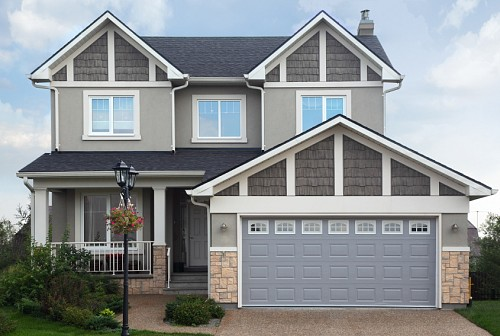Garage doors are the largest moving part of your house. They need consistent maintenance in order to function quietly and properly. The following basic DIY garage door maintenance tasks can be performed as needed, or once every three months.

How to lubricate a noisy garage door: There are a few big no-no's when it comes to lubricating a noisy garage door, according to Phoenix garage door contractor Precision Garage Door. The first big no-no is using WD-40 to lubricate the garage door parts. Instead, the garage door pros recommend using a lithium spray lubricant, or a silicone spray lubricant. These are the parts of the garage door that you will spray with your lithium spray lubricant: the top of the chain rail, metal rollers with ball bearings, hinges, stems, nubs, the arm bar, and the lock. These are the parts of your garage door that you will not spray with lubricant: the bottom of the chain rail, the spring, the chain, and the garage door track.
How to clean a garage door track: Please do not spray lubricant into a garage door track in the event that it seems to be sticky or noisy. The lubricant will not help your garage door track to function better. Instead, it will collect particulate matter, which will harden like cement. Instead of lubricating a garage door track, what you need to do is clean it. Simply wipe the inside of the garage door track with a damp cloth, and dry it. If you need to apply a solvent to remove sticky residue inside the garage door track, WD-40 is actually the right substance to spray on the track, as it is a grease cutter rather than a true lubricant. (WD-40 is also an effective solvent for removing hair dye stains from a sink and other such stains.)
How to realign garage door sensors: If your electric garage door opener sensors are not working, it could be because they have been knocked out of line and need to be realigned. According to a home maintenance professional in Puget Sound, to realigning garage door sensors only requires gently pushing sensors into a position in which they face each other. The sensors should have lights that blink when they are not aligned properly. Reposition the sensors so that their lights are solid, rather than blinking.
How to reset your electric garage door opener: If your garage door closes briefly and then automatically opens, or if it stops closing before it meets the ground, your electric garage door opener needs to be reset. Although every garage door opener functions a little differently, for many garage door openers the following instructions will be applicable: Shut off the power at the breaker, or unplug the garage door opener. Wait 10 seconds, and turn the power back on. Press the down arrow button, and keep pressing it until the door has closed completely. Then hit the "set" button. Next, hit the up arrow button and hold it until the door is about six inches from the garage door opener. Hit the "set" button.
How to install garage door weather seals: Installing weather seals can help you to save energy, and can prevent moisture from entering your garage. Weather seals can also improve garage door security in a small way. The three parts of your garage door that you will need to apply weather seals to are the bottom edge of the door, on the garage door frame, and in-between garage door panels. Cut the weather strip for the bottom edge of the garage door to size, and then apply it with Liquid Nails for a super tight fit. Next, you will screw or nail in the weather strip. For the weather seals on the door frame, you'll need to install the top (horizontal) weather seal first, then the side seals. Screw them in with self-anchoring galvanized screws. Don't forget to caulk around the weather seals on the door frame. You'll use small compressed foam strips to seal between garage door panels.





